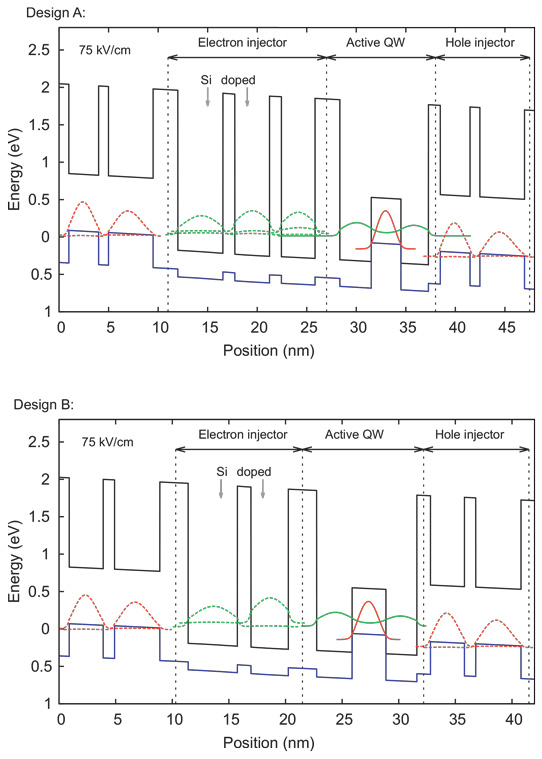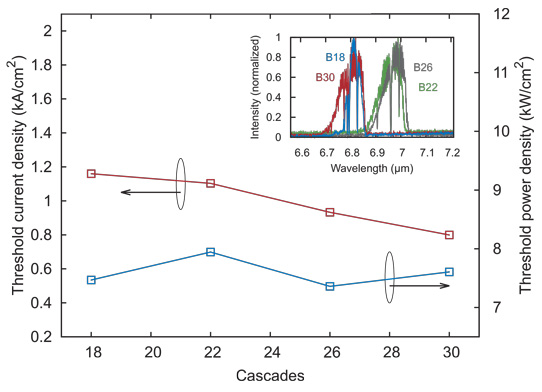- News
18 February 2015
Long-wavelength room-temperature InAs interband cascade lasers
Researchers from Germany and the UK claim record long wavelengths of 7μmfor interband cascade lasers (ICLs) based on indium arsenide (InAs) heterostructures [Matthias Dallner et al, Appl. Phys. Lett., vol106, p041108, 2015]. Devices with threshold current densities less than 1kA/cm2 were fabricated by the team from University of Würzburg and University of St. Andrews. "These pulsed threshold current density values are the lowest at room temperature reported so far for InAs-based ICLs," the researchers add.
The team sees applications for efficient and reliable InAs ICL sources as including tunable laser absorption spectroscopy (TLAS). The 3-5.6μmwavelength range for such applications could be covered by gallium antimonide (GaSb, 726meV bandgap) devices, but longer wavelengths require the narrower bandgap of InAs (354meV). At cryogenic temperatures InAs-based devices have achieved wavelengths as long at 10.4μm. For room-temperature operation, InAs ICLs have previously managed 6.8μmwavelengths.
The heterostructures were produced by molecular beam epitaxy (MBE) on n-type indium arsenide (n-InAs) substrates. Two cascade period designs were grown (Figure 1). The carrier injector sections are described as being 'short', with design B using shorter injectors than A. The researchers comment: "General benefits expected from a shortened injector design are slightly increased mode intensities in the active region and hence a higher gain, and less hetero-interfaces."

Figure 1: Simulations under electric field of 75kV/cm for cascade period designs A and B. Black lines indicate conduction band-edge, blue curve indicates heavy hole band-edge. Electron and hole probability densities are represented by green and orange curves, respectively.
The barrier layers in the cascade structures were mostly aluminium antimonide (AlSb) or gallium antimonide. The design A layer sequence was 2.5nm AlSb / 4.55nm InAs / 1.2nm AlSb / 3.5nm InAs / 1.2nm AlSb / 3.4nm InAs / 2.5nm AlSb / 3.15nm InAs / 3.0nm Ga0.76In0.24Sb / 2.75nm InAs / 1.0nm AlSb / 3.0nm GaSb / 1.0nm AlSb / 4.5nm GaSb / 2.5nm AlSb.
Design B replaced the three-well electron injector region 2.5nm AlSb / 4.55nm InAs / 1.2nm AlSb / 3.5nm InAs / 1.2nm AlSb / 3.4nm InAs with the shorter two-well sequence 2.5nm AlSb / 4.35nm InAs / 1.2nm AlSb / 3.3nm InAs.
The number of cascade sections in the fabricated devices was increased on previous work by the group to compensate for the higher losses expected from trying to extend the emission wavelength. Also, electron-hole wavefunction overlap was expected to be reduced in the active region of the cascade period.
The cascade region was sandwiched between thick equal-width InAs waveguide layers (1130nm-1370nm). The cladding was 1600nm highly silicon-doped n-InAs.
The epitaxial material was fabricated into ridge waveguide lasers with silicon nitride and silicon dioxide passivation to avoid current leakage. The devices were cleaved into laser bars and tested epi-side up without facet treatment. The current injection was pulsed (1kHz, 100nsecs) to avoid self-heating effects.
A device using design A with 22-periods (A22) emitted laser light with a wavelength of 7μmat 20°C. "This is the longest-wavelength ICL working at room temperature reported so far," the researchers write.
The gross dimensions of the device were 2mmx45μm. The threshold current density at 20°C was 940A/cm2. The researchers say that the reduced threshold compared with their previous work was due to "higher doping in the active region for carrier rebalancing and the increased number of cascades". The maximum operating temperature was 55°C.
A rate of 4.8nm/K was found for tuning of the wavelength by changing the temperature. Cryogenic-temperature ICLs with similar wavelength emission tend to have a tuning rate of 3.2nm/K.

Figure 2: Threshold current densities (red) and threshold power densities (blue) of ICLs using samples B18 (18 cascades), B22, B26 and B30. Inset: emission spectra of devices at 20°C.
A 22-period design B device (B22) with the same dimensions had a slightly higher threshold of 1100A/cm2 at 20°C (Figure 2). However, a B device with 30 periods had a threshold at 800A/cm2 – "the lowest pulsed threshold current density at room temperature reported for InAs-based ICLs so far", according to the researchers.
InAs interband cascade lasers InAs Cascade lasers MBE
http://dx.doi.org/10.1063/1.4907002
The author Mike Cooke is a freelance technology journalist who has worked in the semiconductor and advanced technology sectors since 1997.


